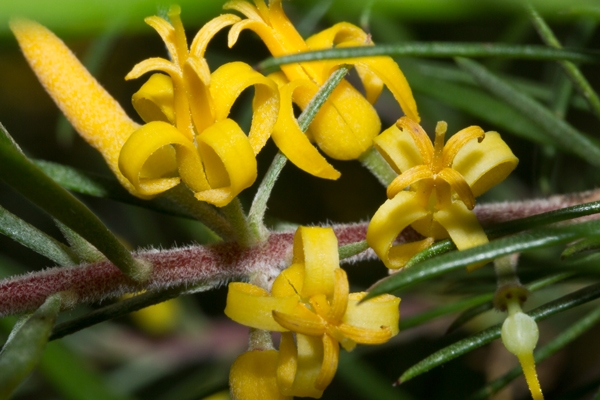Narrow-Leaf Geebung
(Persoonia linearis)
Narrow-Leaf Geebung (Persoonia linearis)
/
/

Lrd390
CC BY-SA 3.0
Image By:
Lrd390
Recorded By:
Copyright:
CC BY-SA 3.0
Copyright Notice:
Photo by: Lrd390 | License Type: CC BY-SA 3.0 | License URL: https://creativecommons.org/licenses/by-sa/3.0 | Uploader: Lrd390 | Publisher: Wikimedia Commons | Title: Grose-Vale-Persoonia-linearis.jpg | Notes: {{Information |Description={{en|1=California or desert bluebell (''[[Phacelia campanularia]]'') seedlings}} |Source=http://www.flickr.com/photos/erutuon/4584199739/ |Author=[[w:Erutuon|Erutuon]] |Date=2010-05-06 |Permission= |other_versions= }} [[Categor |










































Estimated Native Range
Summary
Persoonia linearis, commonly known as Narrow-Leaf Geebung, is an evergreen shrub native to open eucalypt woodlands and dry sclerophyll forests in Eastern Australia. It typically grows to a height of 3-10 feet (1-3 meters) with a similar spread, featuring narrow, linear leaves that are dark green and leathery in texture. The plant produces small, tubular yellow flowers from late spring to early autumn, which are moderately showy and attract pollinators. The bark is papery and can peel in strips, while the fruit is a green drupe that turns purplish upon ripening.
Narrow-Leaf Geebung is valued for its low maintenance requirements and adaptability to a range of light conditions, making it suitable for use in native plant gardens, as a screen or hedge, and in mixed shrub borders. It is tolerant of drought once established and can thrive without fertilization, especially in soils low in phosphorus. Care should be taken to avoid phosphorus-rich fertilizers, as Persoonia species are sensitive to phosphorus toxicity. Iron and manganese deficiencies can occur, which manifest as yellowing of the leaves (chlorosis). In cultivation, it is best to mimic its natural conditions by providing well-drained, acidic soil and ensuring it receives either part shade or full sun. While generally pest-free, it can be susceptible to root rot in poorly drained soils.CC BY-SA 4.0
Narrow-Leaf Geebung is valued for its low maintenance requirements and adaptability to a range of light conditions, making it suitable for use in native plant gardens, as a screen or hedge, and in mixed shrub borders. It is tolerant of drought once established and can thrive without fertilization, especially in soils low in phosphorus. Care should be taken to avoid phosphorus-rich fertilizers, as Persoonia species are sensitive to phosphorus toxicity. Iron and manganese deficiencies can occur, which manifest as yellowing of the leaves (chlorosis). In cultivation, it is best to mimic its natural conditions by providing well-drained, acidic soil and ensuring it receives either part shade or full sun. While generally pest-free, it can be susceptible to root rot in poorly drained soils.CC BY-SA 4.0
Plant Description
- Plant Type: Shrub
- Height: 6-15 feet
- Width: 5-15 feet
- Growth Rate: Moderate
- Flower Color: Yellow
- Flowering Season: Summer, Fall
- Leaf Retention: Evergreen
Growth Requirements
- Sun: Part Shade, Full Sun
- Water: Low, Medium
- Drainage: Slow, Medium
Common Uses
Edible*Disclaimer: Easyscape's listed plant edibility is for informational use. Always verify the safety and proper identification of any plant before consumption., Low Maintenance
Natural Habitat
Open eucalypt woodlands and dry sclerophyll forests
Other Names
Common Names: Fine-Leaf Geebung
Scientific Names: , Persoonia linearis, Persoonia pruinosa, Linkia linearis, Pentadactylon angustifolium, Persoonia breviuscula, Persoonia filifolia, Persoonia linearis var. latior, Persoonia linearis var. sericea, Persoonia pentadactylon
GBIF Accepted Name: Persoonia linearis Andr.